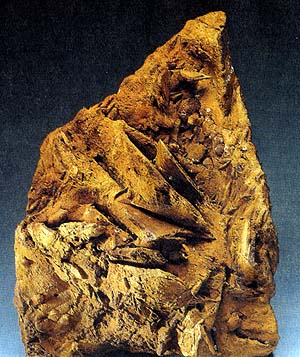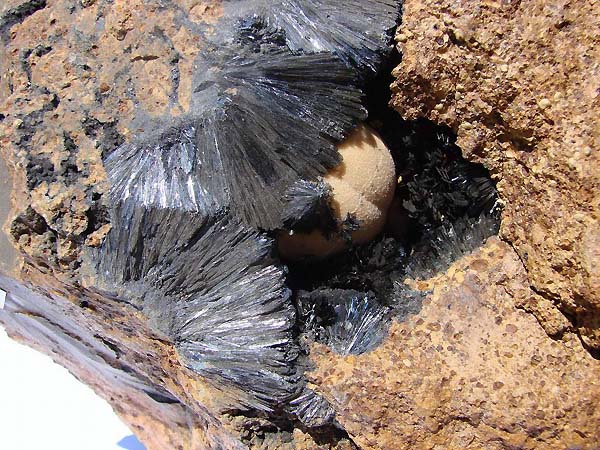Oxides and hydroxides: Limonite
 Diagnostic card.
Diagnostic card.
On the picture. Crystals of hemimorphite in the cluster of limonite from Mexico
Shingonia changeable
Hardness 5-5,5
Specific gravity about 4
Cleavage is absent
Fracture shell or earthy
Color brown-yellow, black
Color in powder brown-yellow
Glitter earthy to porcelain
It represents a mixture of various iron oxides, among which goethite and lepidocrocite are present. Limonite is never observed in the form of crystals; Most often occurs in the form of yellowish earthy masses, easily destroyed, or rounded brown accumulations and light crusts.
Limonite (brown iron ore). Mineral mixture arising from the decomposition of iron-containing minerals; The main mass in it is usually finely crystalline or acicular goethite (needle iron ore) - iron hydroxide. Glitter is glass ("brown glass head"), dim. Opaque. Color yellow to dark brown. The line is yellow to brown. Fracture is conchoidal, rusty or earthy. Cleavage is absent.
The forms of excretion can be earthy, fibrous, oolithic, dense, stained ("brown glass head"). Varieties of limonite ore are leguminous ores, meadow, or marsh, ore and yellow earthy ocher. Deposits: Lorraine - Luxembourg (minette ore), Lower Saxony and Bavaria (Germany), England, CIS (Kerch, Ural, Karelia, etc.).
Diagnostic signs.
Hardness is difficult to determine, since the mineral is easily crumbled. It can vary depending on the components that make up the unit. Usually the material is scratched with a knife. Melts, when heated in a glass tube emits a large amount of water. Behavior in acids. It dissolves in HCl.
Chemical composition. Iron oxide (Fe2O3) 86-89%, water (H2O) 10-14%. Form of crystalline precipitates. Fine-crystalline, fibrous, columnar aggregates, earthy, solid masses, kidney-like concretions, stalactite-like and spherical forms (brown "glass head"), oolitic and bean ores are very common. Cleavage. Good.
Origin.
Limonite is a secondary formation formed in the oxidation zone of iron deposits ("iron hats"). In tropical and subtropical climates it forms when carbonate and silicate rocks are dissolved (laterite formation). It can also be of organic origin, when in the marsh conditions (a favorite medium for the action of bacteria) iron hydroxides precipitate.
Place of Birth.
The most significant in terms of industrial development are laterite deposits in Cuba, Venezuela, Brazil, Angola, Congo, Canada and India. The widely known deposits of Alsace and Lorraine have sedimentary genesis.
Application.
Limonite in modern ferrous metallurgy is not used widely because it contains traces of phosphorus. An earthy variety (yellow ocher) is used in the manufacture of paints and as a molding material.

Barite, Vivianite (Kerchite) in limonite. Kamysh-Burun, Kerch, Crimea, Ukraine.

Goethite (limonite). Orlovsky District, Khalilovsky District, Yu. Ural, Russia. Photo: © А.А. Evseev.
- Ghetchellit - "New Almaden blend" - arsenide and antimony sulfide (modern sulfosol)
- Antimony is a toxic metal (semimetal) , widely used in metallurgy, medicine and engineering
- Zirconium - a rare and undiscovered metal and the most dangerous precious stone in oxide and salt
- Gold - yellow dangerous and poisonous metal of modern accurate digital and cable technologies
- Sulfur is a golden-yellow toxic substance and a sign of active volcanic activity
- Cadmium is an undisputed toxic silvery metal unknown to a wide range of people
- Lead - a toxic gray imitator of metallic silver and toxic metal blende
- Arsenic is a classic poison of medieval and modern poisoners and medicine in medicine
Poisonous and radioactive dangerous stones and minerals
** - poisonous stones and minerals (mandatory check in the chemical laboratory + explicit indication of toxicity)
** - radioactive stones and minerals (mandatory check on the standard dosimeter + ban on open sales in case of radioactivity exceeding 24 milli / g / h + additional measures of population protection)
Catalog of minerals and semi-precious stones of the world by groups
** - poisonous stones and minerals
** - radioactive stones and minerals


Comments
When commenting on, remember that the content and tone of your message can hurt the feelings of real people, show respect and tolerance to your interlocutors even if you do not share their opinion, your behavior in the conditions of freedom of expression and anonymity provided by the Internet, changes Not only virtual, but also the real world. All comments are hidden from the index, spam is controlled.